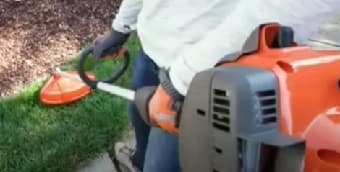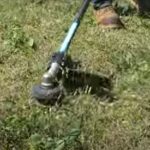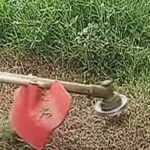As an Amazon Associate, this site earns commissions from qualifying purchases. For more information click here.
Gas weed eaters need fuel to run, so why does the engine die when you add gas? Having sufficient gas is necessary, but unless the fuel actually reaches the engine, the trimmer won’t work. The good news is you do not need to be a specialist to find out what’s wrong. In most cases you can solve the problem with a few basic tools.
If a weed eater stalls when you give it gas, it usually means the fuel filter is clogged. There is sufficient fuel to start the engine but due to clogging, there is not enough to keep the throttle going.
Before you try any of the following, please follow all safety precautions. Have your weed eater owner’s manual by your side. Observe all the guidelines provided there.
In these troubleshooting tips you might need to use screwdrivers or wrenches. Some models might require different screwdriver sizes. This information is in your owner’s manual.
These tips are for gas-powered weed eaters or string trimmers. Be careful when handling fuel and perform these operations outdoors.
Not Enough Fuel
If you added an insufficient amount of gas, the weed eater will not start. These machines like the Husqvarna 128LD require a specific amount to run and provide good performance.
Check your owner’s manual for info on how much fuel to add. The fuel tank should have a line indicating how much fuel to put in. Pour the amount required.
Use only the right fuel to avoid problems. String trimmers and weed eaters often use regular unleaded with 10% or less ethanol. Anything higher than 10% and the risk of engine damage increases. Fortunately, a lot of the stuff sold in gas stations have 10% ethanol so your weed eater is safe.

Wrong Fuel Mix
String trimmers use either a 2-stroke or 4-stroke engine. A 2-stroke engine requires a mixture of oil and gas, typically at a 40:1 ratio. Some models might use a 50:1 mix so check your manual.
The mixture has to be exactly at the right ratio. A slight mistake can have a significant effect on the engine. Your weed eater might not start at all, or it might start but stall. In some cases the engine stalls when you add gas.
These and other problems can arise from an incorrect fuel mix. Fortunately, the owner’s manual makes it clear what ratio to use. By using the right fuel and mixture, a lot of fuel related issues can be avoided.
Fuel Filter Needs Replacement
When you put gas in the fuel tank, it passes through the fuel filter. If the filter is clogged, the fuel will not reach the carburetor. A small amount might reach the engine, but not enough to keep it running.
A filter clogged with impurities also means the engine is being fed low quality fuel. So the trimmer is not only getting limited gas but of poor quality too.
If the filter is blocked, gas won’t get to the engine. It does not matter how much you add. Pouring more fuel might make things worse as it gets contaminated by impurities in the filter.
There are two ways to fix this: clean or replace the filter. The easy solution is to replace it. Fuel filters are often compatible with Husqvarna , Ryobi, Craftsman and other brands and easy to use.
While air filters are reusable after cleaning, most fuel filters are replaced. It takes a lot of dirt to block fuel filters, and when this happens it is probably time to get a replacement anyway.
To replace the fuel filter, you have to take out the spark plug and fuel lines. You also have to empty the fuel tank first. Once you have installed the new filter, put the parts you removed and the trimmer should be ready to use.
Carburetor Issues
If there is a problem with your weed eater you have to look at the carburetor. This is where fuel and air are mixed and idle speed is adjusted. Incidentally you should also look at the carburetor if the trimmer clutch is not working.
Any number of things can go wrong, but let us start at the simplest. Most carburetor problems are due to simple clogging. The more you use the weed eater the dirtier it gets. Eventually the debris starts to affect its ability to mix fuel and air.\\
You will need a carburetor rebuild kit compatible with the string trimmer. If the brand is Echo for instance you can use the HOODELL SRM-210 GT-200R Carburetor Kit. It comes with all the essential parts including a spark plug, air filter and primer bulb.
How to fix a carburetor.
- Turn off your weed eater.
- Use a screwdriver to remove the screws on the back engine cover. Lift the cover up.
- Drain the fuel. Take the carburetor out. You may have to remove some fuel lines and other cables. Note where these connectors go as you have to put everything back again.
- Use a carburetor cleaning solution. Follow the cleaning product instructions.
- Put the carburetor back.
- Add fuel.
Turn the weed eater one. If it runs, the system just needed cleanup. If the engine stalls, try the following.
Adjust the idle speed. The carburetor has adjustable screws, one of which is for idle engine speed. Use a screwdriver and turn the screw by 1/4.
Turn the engine on and see if it runs. If it does not, turn the screw again by 1/4. Keep repeating until the engine is revving consistently.
If this does not work, there are two more things you can check. The first is the diaphragm, that carburetor part with the flaps. These get worn out with use and need to be replaced. There are diaphragm kits available.
The second component is the metering diaphragm, which controls trimmer speed. This can also be replaced. Keep in mind you have to rebuild the carburetor if you are going to replace some parts.
Blocked Exhaust System
The exhaust system, not surprisingly, can get clogged. Just like other parts of a weed eater, it needs to be cleaned on a regular basis. Unlike the primer bulb or spark plug, cleaning should be enough in most cases.
There are no rules which say how often you should clean the exhaust. But you should include it as part of the regular maintenance. The design may vary among various string trimmers but their function is similar. If something gets damaged you should have no problems finding a replacement online.
Defective Primer Bulb
The primer bulb draws fuel from the fuel and sends it to the carburetor. It is responsible for making sure there is a sufficient amount of gas going into the carburetor.
The primer bulb does not get a lot of attention when it comes to weed eater troubleshooting, but it is important. Signs of damage include cracks and dents. Replace the primer bulb immediately to prevent further damage.
Clogged Air Filter
An air filter has two purposes: to allow air into the engine to cool the system, and second, supply air for the fuel. After gas goes through the fuel filter, it is sent to the carburetor to be mixed with air. If the air filter is dirty, the engine will be deprived of air.
Weed eaters need a specific amount of air and fuel, and too much of either one is not good. Without enough air the fuel will not burn. Adding more gas is not going to help because there is no shortage, as it is the lack of air that is the issue.
There are two ways to solve this: clean or replace the air filter.
If the filter is very dirty or more than a year old, replace it. If the filter is new, cleaning is going to be enough.
- Turn off the weed eater.
- Remove the air filter cover.
- Remove the filter. Clean its housing.
- Wash the filter under running water. If that does not remove all the dirt, leave the filter in a container of soapy water for a few minutes. Rinse afterwards.
- Allow the filter to dry.
- Put the filter back on. Replace the cover and turn the weed eater on.
You use the same steps to replace the air filter. However, you just clean its housing, discard the filter and install a new one.

I love the outdoors and all the tools for maintaining gardens, yards and lawns. The only thing I am more passionate about is sharing what I know about garden and outdoor equipment.


